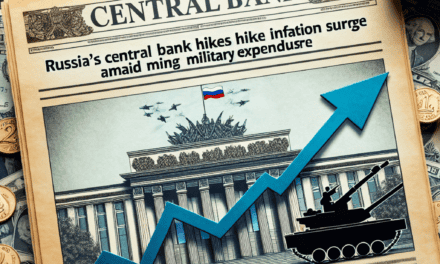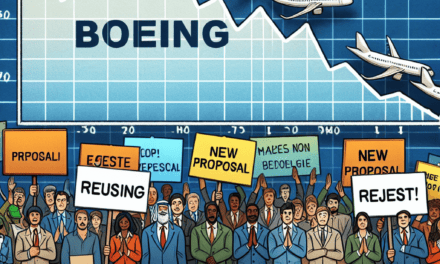“Dow Dips: Market Rally Hits Pause Before Crucial CPI Reveal”
Introduction
Stocks experienced a downturn as the Dow Jones Industrial Average led the decline, halting a recent rally in anticipation of the upcoming Consumer Price Index (CPI) report. Investors exercised caution, reassessing their positions amid concerns over inflationary pressures and potential shifts in monetary policy. The market’s pullback reflects heightened sensitivity to economic indicators that could influence the Federal Reserve’s future actions. As traders await the CPI data, which is expected to provide further insight into inflation trends, the pause in the rally underscores the prevailing uncertainty and the market’s reactive nature to economic signals.
Impact Of CPI Reports On Stock Market Trends
The stock market is a complex ecosystem influenced by a myriad of factors, with economic indicators playing a pivotal role in shaping investor sentiment and market trends. Among these indicators, the Consumer Price Index (CPI) holds significant sway, as it provides a measure of inflation by tracking changes in the prices paid by consumers for goods and services. As such, the anticipation of a CPI report can lead to heightened market volatility, as investors adjust their strategies based on expected inflationary trends. This dynamic was recently observed when the Dow Jones Industrial Average experienced a downturn, dragging stocks lower as the market rally paused in anticipation of the upcoming CPI report.
The CPI report is crucial because it offers insights into the purchasing power of consumers and the overall economic health. A higher-than-expected CPI can signal rising inflation, prompting concerns about potential interest rate hikes by the Federal Reserve. Such hikes are typically implemented to curb inflation but can also lead to increased borrowing costs, which may dampen consumer spending and corporate profits. Consequently, investors often react to CPI data by reassessing their portfolios, leading to fluctuations in stock prices.
In the days leading up to a CPI report, market participants often adopt a cautious stance, as evidenced by the recent decline in the Dow. This caution stems from the uncertainty surrounding inflationary pressures and their potential impact on monetary policy. Investors may choose to lock in profits from previous gains, contributing to a temporary pause in market rallies. Additionally, sectors that are particularly sensitive to interest rate changes, such as technology and consumer discretionary, may experience heightened volatility as investors weigh the implications of the forthcoming data.
Moreover, the anticipation of the CPI report can lead to a broader reassessment of economic conditions. Market participants may scrutinize other economic indicators, such as employment data and consumer confidence, to gauge the potential trajectory of inflation. This comprehensive analysis helps investors form a more nuanced understanding of the economic landscape, allowing them to make informed decisions about asset allocation and risk management.
While the immediate reaction to a CPI report can be pronounced, it is essential to consider the broader context in which these data are released. For instance, a single month’s CPI reading may not fully capture underlying inflationary trends, which can be influenced by temporary factors such as supply chain disruptions or seasonal variations. Therefore, investors often look for patterns over several months to discern more persistent trends that could impact long-term investment strategies.
In conclusion, the impact of CPI reports on stock market trends is multifaceted, influencing investor behavior and market dynamics in significant ways. As the Dow’s recent decline illustrates, the anticipation of these reports can lead to temporary pauses in market rallies as investors brace for potential shifts in monetary policy. By understanding the implications of CPI data and considering the broader economic context, investors can better navigate the complexities of the stock market and make informed decisions that align with their financial goals. As such, the CPI remains a critical tool for market participants seeking to understand and anticipate the forces shaping the economic landscape.
Understanding The Dow’s Influence On Market Movements
The Dow Jones Industrial Average, often referred to simply as “the Dow,” is one of the most closely watched stock market indices in the world. It serves as a barometer for the overall health of the U.S. economy and is a key indicator for investors, policymakers, and analysts alike. When the Dow experiences significant movements, it can have a ripple effect across global markets. Recently, the Dow has been dragging stocks lower, causing a pause in the rally that had been building momentum. This shift in market dynamics comes at a critical juncture, as investors eagerly await the upcoming Consumer Price Index (CPI) report, which is expected to provide further insights into inflationary pressures and economic conditions.
The Dow’s influence on market movements is profound, primarily because it comprises 30 of the largest and most influential companies in the United States. These companies span various sectors, including technology, finance, healthcare, and consumer goods, making the Dow a comprehensive reflection of the broader economy. When the Dow declines, it often signals investor concerns about economic growth, corporate earnings, or geopolitical tensions. Consequently, other indices, such as the S&P 500 and the Nasdaq, may also experience downward pressure as market sentiment shifts.
In the current scenario, the Dow’s decline can be attributed to a combination of factors. Firstly, there is growing uncertainty surrounding the Federal Reserve’s monetary policy. As inflation remains a pressing concern, investors are speculating about potential interest rate hikes, which could impact borrowing costs and consumer spending. This uncertainty is compounded by mixed economic data, which has left market participants grappling with conflicting signals about the strength of the recovery. Furthermore, geopolitical tensions and supply chain disruptions continue to weigh on investor sentiment, adding to the market’s volatility.
As the rally pauses, all eyes are on the forthcoming CPI report. The Consumer Price Index is a critical measure of inflation, tracking changes in the prices of a basket of goods and services over time. A higher-than-expected CPI reading could reinforce fears of persistent inflation, prompting the Federal Reserve to adopt a more aggressive stance on interest rates. Conversely, a lower reading might alleviate some concerns, providing a boost to market confidence. Therefore, the CPI report is poised to play a pivotal role in shaping investor expectations and influencing market movements in the near term.
In anticipation of the CPI report, investors are adopting a cautious approach, reassessing their portfolios and adjusting their strategies accordingly. This cautiousness is reflected in the subdued trading volumes and increased volatility observed in recent sessions. As market participants brace for potential surprises, the Dow’s performance remains a focal point, serving as a gauge for broader market sentiment.
In conclusion, the Dow’s recent drag on stocks underscores its significant influence on market movements. As the rally pauses ahead of the CPI report, investors are navigating a complex landscape marked by economic uncertainty and geopolitical challenges. The outcome of the CPI report will likely have far-reaching implications, shaping the trajectory of the markets in the coming weeks. As such, understanding the Dow’s role in this context is crucial for investors seeking to make informed decisions in an ever-evolving financial environment.
Analyzing The Pause In Stock Market Rallies
The recent pause in the stock market rally, as evidenced by the Dow Jones Industrial Average dragging stocks lower, has captured the attention of investors and analysts alike. This development comes at a critical juncture, as market participants eagerly await the upcoming Consumer Price Index (CPI) report. The anticipation surrounding this report is palpable, given its potential to influence the Federal Reserve’s monetary policy decisions. As such, understanding the factors contributing to the current market dynamics is essential for investors seeking to navigate these uncertain waters.
To begin with, the stock market’s recent rally can be attributed to a confluence of factors, including robust corporate earnings, a resilient labor market, and a generally accommodative monetary policy stance. However, the rally’s momentum has been tempered by growing concerns over inflationary pressures. The CPI report, which measures the average change in prices paid by consumers for goods and services, serves as a critical barometer for inflation. A higher-than-expected CPI reading could signal that inflation is becoming more entrenched, potentially prompting the Federal Reserve to adopt a more hawkish stance.
Moreover, the global economic landscape adds another layer of complexity to the current market environment. Supply chain disruptions, geopolitical tensions, and energy price volatility have all contributed to inflationary pressures, complicating the Federal Reserve’s task of balancing economic growth with price stability. In this context, the upcoming CPI report takes on added significance, as it will provide crucial insights into the trajectory of inflation and its potential impact on monetary policy.
In addition to inflation concerns, the recent pause in the stock market rally can also be attributed to profit-taking by investors. After a prolonged period of gains, some market participants may be opting to lock in profits, leading to a temporary pullback in stock prices. This behavior is not uncommon, as investors often reassess their portfolios in light of new economic data and market conditions. Furthermore, the pause in the rally may also reflect a broader sense of caution among investors, who are keenly aware of the potential for increased market volatility in the coming months.
Transitioning to the implications of these developments, it is important to consider how the Federal Reserve might respond to the evolving economic landscape. Should the CPI report indicate a significant uptick in inflation, the central bank may feel compelled to accelerate its timeline for tapering asset purchases or raising interest rates. Such actions could have far-reaching consequences for financial markets, as higher interest rates typically lead to increased borrowing costs and reduced liquidity. Consequently, investors may need to adjust their strategies to account for a potentially less accommodative monetary environment.
In conclusion, the recent pause in the stock market rally, as highlighted by the Dow’s decline, underscores the complex interplay of factors influencing investor sentiment. As the market awaits the CPI report, concerns over inflation and monetary policy loom large, prompting investors to adopt a more cautious stance. While the current environment presents challenges, it also offers opportunities for those who are able to navigate the shifting landscape with agility and foresight. As always, staying informed and maintaining a diversified portfolio remain key strategies for managing risk and capitalizing on potential market opportunities.
Investor Sentiment Ahead Of Key Economic Indicators
Investor sentiment has taken a cautious turn as the Dow Jones Industrial Average led a decline in stock markets, pausing a recent rally. This shift in momentum comes as investors brace themselves for the upcoming Consumer Price Index (CPI) report, a key economic indicator that could provide further insights into the Federal Reserve’s future monetary policy decisions. The anticipation surrounding the CPI report has created an atmosphere of uncertainty, prompting market participants to reassess their positions and strategies.
The Dow’s recent downturn can be attributed to a combination of factors, including profit-taking after a period of gains and growing concerns about inflationary pressures. As the CPI report looms, investors are keenly aware that any indication of rising inflation could influence the Federal Reserve’s approach to interest rates. A higher-than-expected CPI reading might prompt the central bank to consider tightening monetary policy sooner than anticipated, which could have significant implications for equity markets.
In addition to inflation concerns, geopolitical tensions and global economic uncertainties have also contributed to the cautious sentiment. Investors are closely monitoring developments in international trade relations and potential disruptions in global supply chains, which could further exacerbate inflationary pressures. These factors, combined with the anticipation of the CPI report, have led to increased volatility in the markets, with investors seeking safe-haven assets to mitigate potential risks.
Despite the current pause in the rally, some analysts remain optimistic about the long-term prospects of the stock market. They argue that the underlying fundamentals of the economy remain strong, with robust corporate earnings and a resilient labor market providing a solid foundation for future growth. However, they also acknowledge that the path forward may be uneven, with periodic bouts of volatility as markets adjust to evolving economic conditions.
As investors navigate this uncertain landscape, diversification and risk management have become increasingly important. Many are reevaluating their portfolios to ensure they are well-positioned to weather potential market fluctuations. This includes a focus on sectors that may benefit from inflationary trends, such as commodities and energy, as well as those that offer defensive characteristics, such as healthcare and consumer staples.
Moreover, the role of technology and innovation in shaping the future of the economy cannot be overlooked. As companies continue to adapt to changing consumer behaviors and technological advancements, sectors such as information technology and renewable energy present compelling opportunities for growth. Investors are paying close attention to these areas, seeking to capitalize on the transformative potential they offer.
In conclusion, the current pause in the stock market rally, led by the Dow’s decline, reflects a broader sense of caution among investors as they await the upcoming CPI report. The outcome of this report could have far-reaching implications for monetary policy and market dynamics. While uncertainties persist, the resilience of the economy and the potential for innovation-driven growth provide reasons for cautious optimism. As investors navigate this complex environment, a focus on diversification, risk management, and strategic positioning will be crucial in achieving long-term success.
Strategies For Navigating Market Volatility
In the ever-evolving landscape of financial markets, investors are constantly seeking strategies to navigate periods of volatility. The recent downturn in the Dow Jones Industrial Average, which has led to a broader decline in stock markets, serves as a timely reminder of the inherent unpredictability of market movements. As the rally pauses ahead of the Consumer Price Index (CPI) report, investors are left pondering the best course of action to protect their portfolios and capitalize on potential opportunities.
To begin with, understanding the factors contributing to market volatility is crucial. The anticipation of the CPI report, which provides insights into inflationary pressures, has created a sense of uncertainty among investors. Inflation data can significantly influence market sentiment, as it impacts interest rate expectations and, consequently, the cost of borrowing. In such an environment, it is essential for investors to remain informed and adaptable, ready to adjust their strategies in response to new information.
One effective approach to managing market volatility is diversification. By spreading investments across various asset classes, sectors, and geographic regions, investors can mitigate the impact of adverse movements in any single area. This strategy not only reduces risk but also enhances the potential for returns, as different assets often react differently to economic events. For instance, while equities may experience a downturn, bonds or commodities might offer stability or even growth, providing a buffer against losses.
Moreover, maintaining a long-term perspective is vital during periods of market turbulence. Short-term fluctuations, while unsettling, are often part of the natural ebb and flow of markets. By focusing on long-term goals and maintaining a disciplined investment approach, investors can avoid the pitfalls of emotional decision-making, which often leads to buying high and selling low. Historical data suggests that markets tend to recover over time, rewarding those who remain patient and committed to their investment strategies.
In addition to diversification and a long-term outlook, employing hedging techniques can offer further protection against volatility. Options and futures contracts, for example, allow investors to hedge against potential losses by locking in prices or setting predetermined levels of risk. While these instruments can be complex and require a thorough understanding, they provide an additional layer of security for those willing to invest the time and effort to learn their intricacies.
Furthermore, staying informed about macroeconomic trends and geopolitical developments is essential for navigating volatile markets. Economic indicators, such as employment figures, GDP growth rates, and central bank policies, can all influence market dynamics. Similarly, geopolitical events, including trade negotiations and political tensions, can create uncertainty and impact investor sentiment. By keeping abreast of these factors, investors can make more informed decisions and adjust their strategies accordingly.
Finally, consulting with financial advisors or utilizing robo-advisors can provide valuable guidance during uncertain times. These professionals and platforms offer personalized advice and automated strategies tailored to individual risk tolerances and investment goals. By leveraging their expertise, investors can gain a clearer understanding of market conditions and receive recommendations that align with their objectives.
In conclusion, while market volatility can be challenging, it also presents opportunities for those who are prepared. By employing strategies such as diversification, maintaining a long-term perspective, utilizing hedging techniques, staying informed, and seeking professional advice, investors can navigate the complexities of volatile markets with greater confidence. As the Dow drags stocks lower and the rally pauses ahead of the CPI report, these strategies offer a roadmap for managing uncertainty and positioning portfolios for future success.
Historical Patterns Of Stock Performance Before CPI Releases
In the intricate world of financial markets, the anticipation of economic data releases often plays a pivotal role in shaping investor sentiment and market movements. One such critical data point is the Consumer Price Index (CPI) report, which serves as a key indicator of inflationary trends within an economy. Historically, the period leading up to the release of the CPI report has been marked by a discernible pattern in stock performance, particularly within the Dow Jones Industrial Average and broader market indices. Understanding these historical patterns can provide valuable insights for investors navigating the complexities of market dynamics.
Traditionally, the days preceding a CPI release are characterized by heightened market volatility and cautious trading behavior. Investors, keenly aware of the potential implications of inflation data on monetary policy and interest rates, often adopt a wait-and-see approach. This cautious sentiment is reflected in the performance of major stock indices, including the Dow, which frequently experiences a pause in its rally as market participants brace for the forthcoming data. The anticipation of the CPI report often leads to a temporary deceleration in market momentum, as traders and investors reassess their positions in light of potential shifts in economic policy.
Moreover, the historical patterns of stock performance before CPI releases are not solely confined to the Dow. Broader market indices, such as the S&P 500 and the Nasdaq, also exhibit similar trends, albeit with varying degrees of sensitivity to inflation data. The anticipation of the CPI report often results in a sectoral rotation within the market, as investors adjust their portfolios to hedge against potential inflationary pressures. Sectors traditionally perceived as more sensitive to inflation, such as consumer staples and utilities, may experience increased investor interest, while growth-oriented sectors, like technology, might witness a temporary pullback.
In addition to sectoral shifts, the historical patterns of stock performance before CPI releases are also influenced by broader macroeconomic factors. For instance, the prevailing economic environment, including the state of the labor market and consumer spending trends, can significantly impact investor expectations regarding inflation. During periods of robust economic growth, the anticipation of a higher CPI reading may lead to increased market anxiety, as investors weigh the potential for tighter monetary policy. Conversely, in a sluggish economic environment, a subdued CPI report might be perceived as a positive signal, alleviating concerns over aggressive interest rate hikes.
Furthermore, the historical patterns of stock performance before CPI releases are often shaped by the broader geopolitical landscape. Geopolitical tensions, trade disputes, and global economic uncertainties can exacerbate market volatility, amplifying the impact of the CPI report on investor sentiment. In such scenarios, the Dow and other major indices may experience heightened fluctuations, as market participants grapple with the dual challenges of domestic inflationary pressures and external economic risks.
In conclusion, the historical patterns of stock performance before CPI releases underscore the intricate interplay between economic data, investor sentiment, and market dynamics. As the Dow and other major indices navigate the complexities of inflationary trends, understanding these patterns can provide valuable insights for investors seeking to make informed decisions. By recognizing the factors that influence market behavior in the lead-up to CPI releases, investors can better position themselves to navigate the challenges and opportunities presented by this critical economic indicator.
The Role Of Economic Data In Shaping Market Expectations
Economic data plays a pivotal role in shaping market expectations, influencing investor sentiment, and guiding financial decision-making. As the Dow drags stocks lower, with the rally pausing ahead of the Consumer Price Index (CPI) report, it becomes increasingly evident how crucial economic indicators are in the financial landscape. The anticipation surrounding the CPI report underscores the market’s sensitivity to economic data, as investors keenly await insights into inflationary trends that could impact monetary policy and, consequently, market dynamics.
The CPI, a key measure of inflation, provides valuable information about the average change over time in the prices paid by urban consumers for a market basket of consumer goods and services. As such, it serves as a critical gauge for assessing inflationary pressures within the economy. Investors and policymakers alike scrutinize this data to discern potential shifts in the economic environment. A higher-than-expected CPI reading could signal rising inflation, prompting the Federal Reserve to consider tightening monetary policy by raising interest rates. Conversely, a lower-than-expected figure might suggest subdued inflation, allowing for a more accommodative monetary stance.
In the context of the current market scenario, the pause in the stock rally can be attributed to the uncertainty surrounding the upcoming CPI report. Investors are adopting a cautious approach, reassessing their positions in light of potential changes in inflationary trends. This cautious sentiment is reflected in the Dow’s recent performance, as it drags stocks lower, highlighting the market’s apprehension. The interplay between economic data and market expectations is a delicate balance, where even slight deviations from anticipated figures can lead to significant market reactions.
Moreover, the role of economic data extends beyond immediate market movements. It also influences long-term investment strategies and portfolio allocations. Investors rely on economic indicators to make informed decisions about asset allocation, risk management, and diversification. For instance, in an environment characterized by rising inflation, investors might seek refuge in assets that traditionally perform well during inflationary periods, such as commodities or inflation-protected securities. On the other hand, in a low-inflation scenario, growth-oriented assets might become more attractive.
Furthermore, economic data serves as a barometer for assessing the overall health of the economy. It provides insights into various aspects, such as employment levels, consumer spending, and industrial production, which collectively shape the economic outlook. By analyzing these indicators, investors can gauge the potential for economic growth or contraction, thereby adjusting their expectations and strategies accordingly.
In addition to influencing individual investment decisions, economic data also plays a crucial role in shaping broader market trends. It informs the actions of institutional investors, central banks, and government agencies, all of which contribute to the overall market environment. As these entities respond to economic data, their actions can have far-reaching implications for financial markets, affecting everything from interest rates to currency valuations.
In conclusion, the role of economic data in shaping market expectations cannot be overstated. As evidenced by the current pause in the stock rally ahead of the CPI report, investors are acutely aware of the impact that economic indicators can have on market dynamics. By providing insights into inflationary trends and the broader economic landscape, economic data serves as a vital tool for investors, policymakers, and financial institutions alike. As markets continue to navigate the complexities of the global economy, the importance of economic data in guiding expectations and decision-making remains paramount.
Q&A
1. **What caused the Dow to drag stocks lower?**
– Concerns about upcoming economic data, particularly the Consumer Price Index (CPI) report, led to a pause in the stock market rally, causing the Dow to drag stocks lower.
2. **What is the significance of the CPI report?**
– The CPI report is significant as it provides insights into inflation trends, which can influence Federal Reserve policy decisions and impact market sentiment.
3. **How did investors react to the anticipation of the CPI report?**
– Investors became cautious, leading to a sell-off in stocks as they awaited the CPI report to gauge inflationary pressures and potential interest rate changes.
4. **Which sectors were most affected by the Dow’s decline?**
– Typically, interest rate-sensitive sectors such as technology and consumer discretionary might be most affected, but specific sector performance can vary.
5. **What are the potential implications of a high CPI reading?**
– A high CPI reading could indicate rising inflation, potentially prompting the Federal Reserve to consider tightening monetary policy, which might negatively impact stock markets.
6. **How did other major indices perform in response to the Dow’s decline?**
– Other major indices, such as the S&P 500 and Nasdaq, likely experienced declines as well, reflecting broader market caution ahead of the CPI report.
7. **What strategies might investors consider in such a market environment?**
– Investors might consider diversifying their portfolios, focusing on defensive stocks, or holding cash to mitigate risk until there is more clarity on inflation and interest rates.
Conclusion
The Dow’s decline, as stocks pull back from their recent rally, reflects investor caution ahead of the upcoming Consumer Price Index (CPI) report. This pause suggests that market participants are closely monitoring inflation data to gauge potential impacts on monetary policy and economic outlook. The anticipation of the CPI report underscores its significance in shaping market sentiment and future investment strategies.





